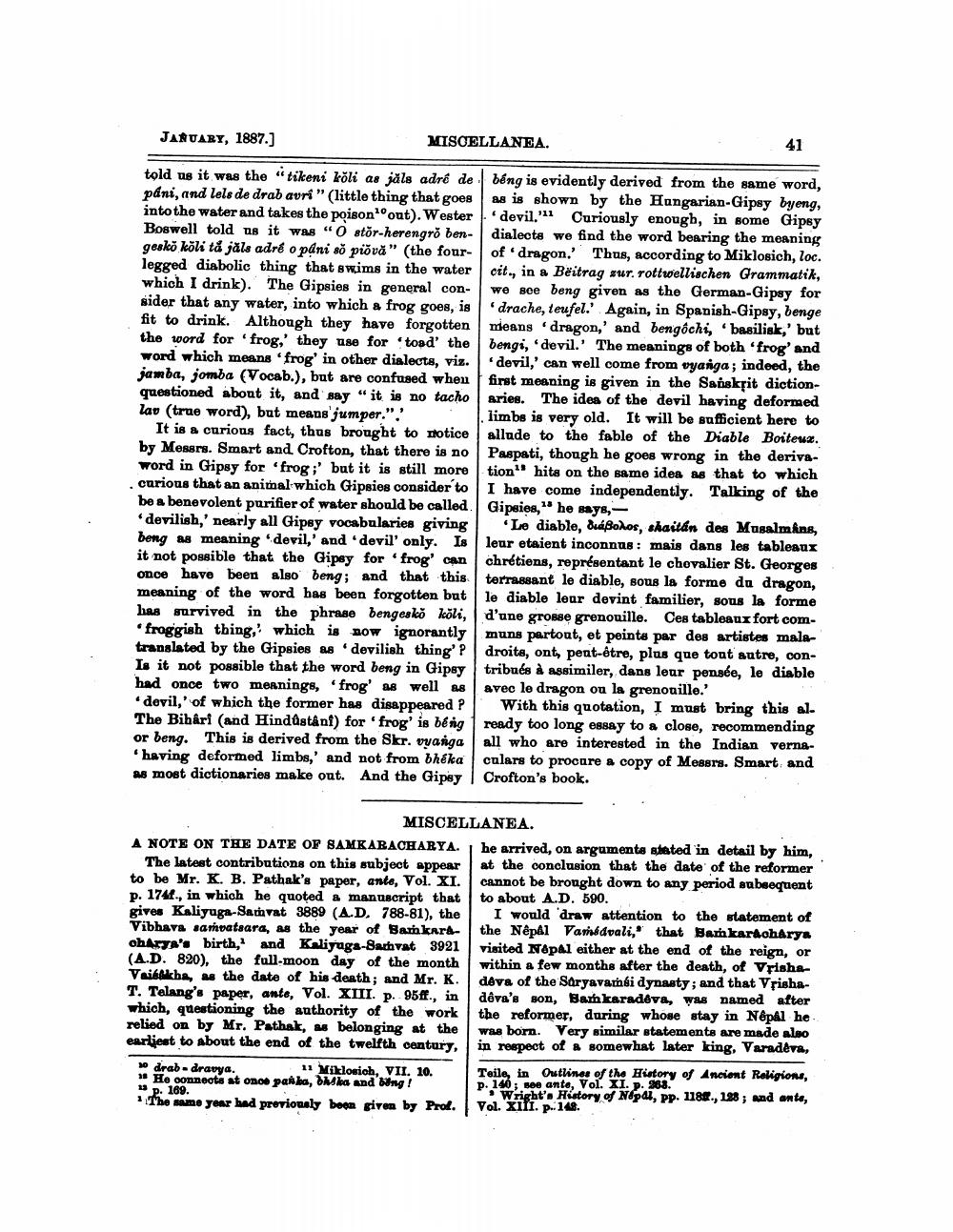________________
JANUARY, 1887.]
MISCELLANEA.
41
told us it was the "tikeni kõli as jáls adre de bếng is evidently derived from the same word, páni, and lels de drab avri" (little thing that goes as is shown by the Hungarian-Gipsy byeng, into the water and takes the poisonout). Wester.devil."1 Curiously enough, in some Gipsy Boswell told us it was “O stör-herengrò ben- dialects we find the word bearing the meaning gesko kõli ta jals adre o pdni so piova" (the four- of dragon. Thus, according to Miklosich, loc. legged diabolic thing that swims in the water cit., in a Beitrag sur. rottwellischen Grammatik, which I drink). The Gipsies in general con- we see beng given as the German-Gipsy for sider that any water, into which a frog goes, is drache, teufel.' Again, in Spanish-Gipsy, benge fit to drink. Although they have forgotten mieans dragon,' and bengochi, basilisk,' but the word for 'frog,' they use for toad' the bengi, "devil.' The meanings of both 'frog' and word which means 'frog' in other dialects, viz. devil,' can well come from vyanga; indeed, the jamba, jomba (Vocab.), but are confused when first meaning is given in the Sanskpit dictionquestioned about it, and say “it is no tacho aries. The idea of the devil having deformed lav (trae word), but means jumper."
limbs is very old. It will be sufficient here to It is a curious fact, thus brought to notice allude to the fable of the Diable Boiteuz. by Messrs. Smart and Crofton, that there is no Paspati, though he goes wrong in the derivaword in Gipsy for 'frog;' but it is still more tion" hita on the same idea as that to which carious that an animal which Gripsies consider to I have come independently. Talking of the be a benevolent purifier of water should be called Gipsies," he says,
devilish,' nearly all Gipsy vocabularies giving Le diable, duáBohor, shaitán des Musalmans, beng as meaning devil,' and 'devil' only. Is leur etaient inconnus: mais dans les tableaux it not possible that the Gipsy for 'frog' can chrétiens, représentant le chevalier St. Georges once have been also beng; and that this terrassant le diable, sous la forme du dragon, meaning of the word has been forgotten bat le diable leur devint familier, sous la forme has survived in the phrase bengesko kõli, d'une grosse grenouille. Ces tableaux fort com
froggish thing, which is now ignorantly muns partout, et peints par des artistes male translated by the Gipsies as devilish thing'? droite, ont, pent-être, plus que tout autre, conIs it not possible that the word beng in Gipsy tribués à assimiler, dans leur pensée, le diable had once two meanings, frog' as well as avec le dragon ou la grenouille. .devil,' of which the former has disappeared ? With this quotation, I must bring this al. The Bihari and Hindustani) for 'frog' is béng ready too long essay to a close, recommending or beng. This is derived from the Skr. vyanga all who are interested in the Indian verna
having deformed limbs,' and not from bhekea culars to procure a copy of Messrs. Smart and as most dictionaries make out. And the Gipsy | Crofton's book.
MISCELLANEA A NOTE ON THE DATE OF BAMKABACHARYA. he arrived, on arguments stated in detail by him,
The latest contributions on this subject appear at the conclusion that the date of the reformer to be Mr. K. B. Pathak's paper, ante, Vol. XI. cannot be brought down to any period subsequent p. 1741., in which he quoted a manuscript that to about A.D. 590. gives Kaliyaga-Samvat 3889 (A.D. 788-81), the I would 'draw attention to the statement of Vibhava samoatsara, as the year of Barkard- the Nepal Vandvali," that Bamkaracharya OhArya's birth, and Kaliyaga-Sachvat 3921 visited Nepal either at the end of the reign, or (A.D. 820), the full-moon day of the month within a few months after the death, of Vrishe Vaibikhe, as the date of his death; and Mr. K. deva of the Saryavansi dynasty; and that VpishaT. Telang's paper, ante, Vol. XIII. p. 95ff., in dôva's son, Bankaradeva, was named after which, questioning the authority of the work the reformer, during whose stay in Nepal he. relied on by Mr. Pathak, as belonging at the was born. Very similar statements are made also earliest to about the end of the twelfth century, in respect of a somewhat later king, Varadeva, 30 drab - dravya.
11 Miklosioh, VII. 10. Teile, in Outlines of the History of Ancient Religions, » Ho connects at once pala, Mia and Bing!
p. 140; see ante, Vol. XI. p. 983. 13 p. 169.
Wright'. History of Népdi, pp. 1184., 128 ; and ante, The name year had previously been given by Prol. Vol. Xill. p.148.




